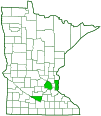soldier fly
(Stratiomys norma)
Conservation • Description • Habitat • Ecology • Distribution • Taxonomy
|
|
||||||||||||||
Description |
Stratiomys norma is a common, large, easily recognized soldier fly. It occurs in the Great Lakes states from New York to Minnesota, south to Pennsylvania and Nebraska, and in Ontario. Adults are black with yellow marking and ½″ (12 to 13 mm) long. The head is more or less hemispherical. There are two large compound eyes on the side of the head and three small but prominent simple eyes (ocelli) in a triangle at the top of the head. On the male the compound eyes meet at the top of the head. On the female they are widely separated. The face is rounded and covered with yellow hairs. On the female, the head is mostly black with a large yellow spot in the middle of the face, yellow around the compound eyes, and yellow at the top of the head (vertex). A small area surrounding the ocelli is black. On the male the head and face are entirely black. The antennae are black, long (for a fly), and are inserted just above the middle of the face. They have three segments. The first segment is three or four times as long as the second. The third segment is as long as the first two segments together, and is divided into five ring-like segments (annulated). It does not have a bristle-like appendage (arista). The thorax is black, more or less square, and densely covered with yellowish and brownish woolly hairs. The exoskeletal plate between the wing bases (scutellum) is prominent and yellow except for a black base and two red spines. The abdomen is as long as the head and thorax together. It is egg-shaped and has five visible segments when viewed from above, thick and convex when viewed from the side. It is black, is covered with yellowish and blackish hairs, and has yellow markings. Segment 2 has a large triangle on each rear lateral margin. Segment 3 has a small elongated triangle on each forward lateral margin; a transverse stripe at each lateral rear margin that does not extend more than half way to the middle; and a small triangle in the middle at the rear margin. Segment 4 has a elongated spot on each forward lateral margin, a transverse stripe at each lateral rear margin, and a large triangle in the middle at the rear margin. The marginal spots on segments 3 and 4 do not extend to the transverse stripe on the rear margin. Segment 5 has a very narrow lateral marginal stripe, and a longitudinal stripe in the middle that is widest in the front. The legs are moderately long. On the male, the third leg segment (femur) of each leg is red with a broad, blackish-brown band near but not at the tip. The basal half of the fourth segment (tibia) is yellow, the outer half red. The tibia have no spurs. The last part of the leg (tarsus), corresponding to the foot, has three pads. The basal half is yellow, the outer half red. The wings are clear and tinted brownish. There are five distinct cells at the outer part of the wing. The radial vein (R) has two branches, and they are crowded in the front of the wing. The posterior branch (Rs) has three branches. The posterior branch of Rs (R5) ends at the margin before the wing tip. The anal cell is longer than the second basal cell and is closed near the wing tip. The knob-like balancing structures (halteres) are pale green. |
Size |
Total length: ½″ (12 to 13 mm) |
Similar Species |
Habitat |
Near streams and ponds |
Ecology |
Season |
|
Behavior |
Larvae live in water. Adults are found on flowers. |
Life Cycle |
The female lays overlapping layers of eggs on the underside of the leaves of aquatic plants. |
Larva Food |
Small aquatic organisms |
Adult Food |
|
Distribution |
||
|
Sources |
|
| 7/7/2024 | ||
Occurrence |
||
Common |
||
Taxonomy |
|
Order |
|
Suborder |
Brachycera |
Infraorder |
Orthorrhapha |
Parvorder |
Stratiomyomorpha (soldier flies and allies) |
Superfamily |
Stratiomyoidea |
Family |
Stratiomyidae (soldier flies) |
Subfamily |
Stratiomyinae |
Tribe |
Stratiomyini |
Genus |
Stratiomys |
Subordinate Taxa |
|
|
|
Synonyms |
|
Stratiomyia quadrigemina |
|
Common Names |
|
This species has no common name. The common name for the family Stratiomyidae is soldier flies, and it is applied here for convenience. |
|
Glossary
Femur
On insects and arachnids, the third, largest, most robust segment of the leg, coming immediately before the tibia. On humans, the thigh bone.
Halteres
In flies: a pair of knob-like structures on the thorax representing hind wings that are used for balance.
Ocellus
Simple eye; an eye with a single lens. Plural: ocelli.
Scutellum
The exoskeletal plate covering the rearward (posterior) part of the middle segment of the thorax in some insects. In Coleoptera, Hemiptera, and Homoptera, the dorsal, often triangular plate behind the pronotum and between the bases of the front wings. In Diptera, the exoskeletal plate between the abdomen and the thorax.
Tarsus
On insects, the last two to five subdivisions of the leg, attached to the tibia; the foot. On spiders, the last segment of the leg. Plural: tarsi.
Tibia
The fourth segment of an insect leg, after the femur and before the tarsus (foot). The fifth segment of a spider leg or palp. Plural: tibiae.
Visitor Photos |
||
Share your photo of this insect. |
||
This button not working for you? |
||
Chelsea M. |
||
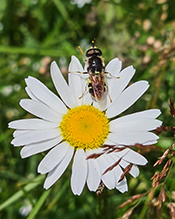 |
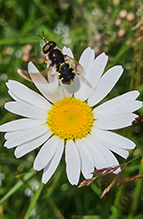 |
|
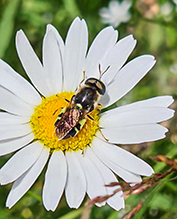 |
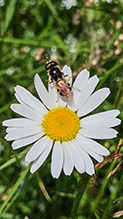 |
|
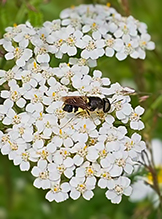 |
||
Alfredo Colon |
||
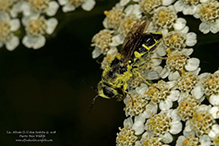 |
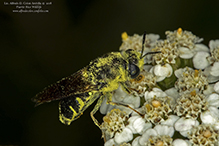 |
|
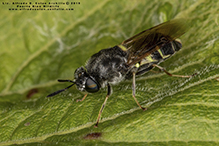 |
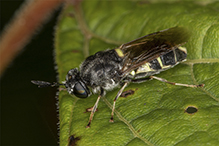 |
|
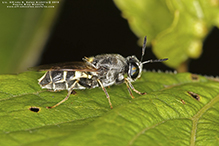 |
||
MinnesotaSeasons.com Photos |
||
|
||
|
||

Slideshows |
|

Visitor Videos |
||
Share your video of this insect. |
||
This button not working for you? |
||
Chelsea M. |
soldier fly Stratiomys norma 01 |
About
soldier fly (Stratiomys norma) |
soldier fly Stratiomys norma 02 |
About
soldier fly (Stratiomys norma) |
Other Videos |
||
Soldier Fly (Stratiomyidae: Stratiomys norma?) Close-up |
About
Published on Jun 24, 2011 With surprisingly 'tick-tock' antennae. ;-) Photographed at Fisher, Minnesota (24 June 2011). |

Visitor Sightings |
||
Report a sighting of this insect. |
||
This button not working for you? |
||
Chelsea M. |
Location: Aitkin, MN |
 |
| Alfredo Colon 8/13/2019 |
Location: Woodbury, MN |
 |
| Alfredo Colon 7/23/2018 |
Location: Woodbury, MN |
 |
MinnesotaSeasons.com Sightings |
||
|

Created: 2/17/2019 Last Updated: © MinnesotaSeasons.com. All rights reserved. |
